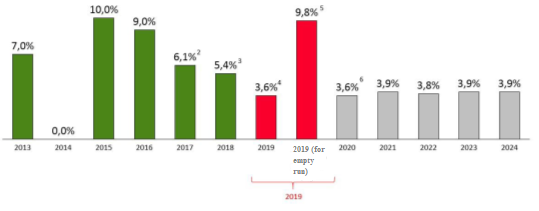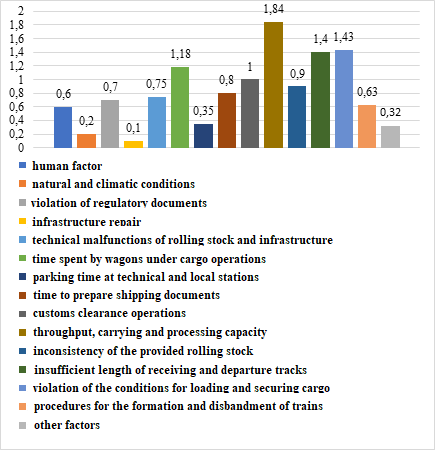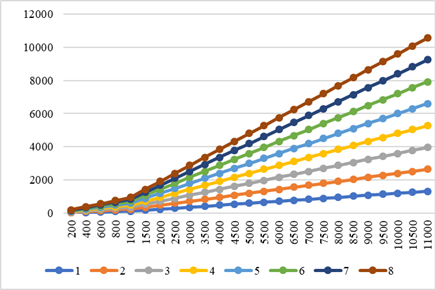Abstract
In the modern conditions of the functioning of the railway transport system, one of the constituent parts of increasing the efficiency of freight traffic is a change in the tariffication system for good. This should primarily reflect the cost aspects of transportation, subject to a high level of quality, take into account the consignor's ability to pay and the competitiveness of the transported products in the international transport market. The article examines the factors influencing the pricing of the tariff for the carriage of goods by rail, provides a methodology for calculating the tariff for the carriage of one ton of cargo, a wagon, as well as a formula for the economic losses of cargo owners. Based on the classification of factors affecting the number of losses of cargo owners when using railway transport services, the estimation of the client's economic losses when using the service "rail transportation" was calculated, which showed a linear dependence of the final result depending on the volume of cargo and delivery time. Taking into account the results obtained during the calculation, it was concluded that it is necessary to create a new transportation technology, which will significantly reduce the delivery time of goods, the cost of transportation and, accordingly, will positively attune a potential client to use the services of railway transport.
Keywords: Economic losses, highly profitable cargo, linear dependence, principles of customer focus, railway transport system
Introduction
In a crisis, the railway transport system seeks to return the lost and attract new customers, creating comfortable conditions for all persons using transport services in the field of freight and passenger transportation. The implementation of transport services has its own peculiarity due to the fact that the production and consumption of services occur simultaneously in contrast to markets where the product is a material form. It should be noted that most transport services are paid in advance, and there is a certain period of time between the moment of payment, production and consumption of the service (Institute of Natural Monopolies, 2019).
In modern conditions, the final results of the work of railway transport are subject to the negative influence of numerous external factors. Any situations - labor and national conflicts, deterioration of the work of individual industrial enterprises, complication of the environmental situation in a number of regions of the country, etc. - all this can lead and sometimes leads to a decrease in the volume of traffic, and, consequently, income and profits of the railways, although there is no fault of the railroad workers in this. Management of railway transport should ensure its efficient operation in any situation, however, the solution of the main task - full and timely satisfaction of the transport needs of society - is often not fulfilled in practice. The actual speed of delivery of goods is often overestimated by statistics (Kraskovsky & Yakovlev, 2015; Research work, 2010).
In the context of constantly increasing competition in the transport services market, in order to ensure the efficiency of the functioning of the railway transport system as a whole and its constituent sectors, one of the key tasks is to preserve the existing freight customer base and maximize the attraction of new users of services. To this end, it is necessary to use new information technologies for the industry, an individual approach to each individual client, the implementation of non-core for the industry and non-standard transportation conditions. They allow us to satisfy the constantly changing client needs, flexibility and an individual approach to each client, prompt decision-making, maximum simplification of document flow, creation optimal logistics solutions for the client of any degree of complexity, that is, increasing the level of the customer focus (Mazo, 2013).
Problem Statement
At present, Russian Railways is developing proposals to change the tariff system after 2025, which includes:
- rejection, from the principle of constructing a tariff based on the average network cost. It was on this principle that tariffs in the USSR and in modern Russia were based. Instead, it proposes accounting for unit costs;
- gradual transition from tariffing for different loads to tariffing not only by type, but also by type of wagons, due to the increasing role that the technical parameters of the rolling stock will play when choosing a tariff (length along the axes of couplers, couplers, carrying capacity, etc.);
- complete unification of the empty run of the car from under the cargo of different tariff classes. At present, this tariff has been unified for gondola cars and flatcars, the next step - unification of empty run of covered wagons - is quite logical.
- idea of individualizing the tariff, or increasing the degree of individualization;
- taking into account the initial and final operations not only in the tariff for the loaded run, but also in the tariff for the empty run of the car (Khusainov, 2016; Khusainov, 2020).
Research Questions
The main factors in the struggle for a client between carriers are the use of modern digital technologies and customer focus, which in turn makes it possible to recognize the client's need, minimize its transport costs, simplify the level of accessibility to the railway service, which will significantly increase the attractiveness of the industry. For a high-quality organization of the transportation process, logistic operators are needed who effectively organize the entire process of cargo delivery and automate this activity. The criteria for choosing the mode of transport and the routing algorithm for organizing transportation were considered in works, the main emphasis in which was placed on optimizing the construction of the route (Grigorieva & Lazareva, 2016; Gozbenko & Olentsevich, 2016; Grigorieva et al., 2020).
The statistics of industry performance indicators reflect an increase in cargo turnover with a decrease in loading, which means the longest possible leg of cargo transportation. At the same time, as can be seen from the structure of cargo loading in the industry, an increase in the amount of transport work is associated largely with the commodity category of cargo and with coal, chemical and mineral fertilizers, timber cargo, non-ferrous ore and sulfur raw materials. That is, that occurred due to the low-margin segment (Komarov & Yuriev, 2016; Krol et al., 2018; Pricelist, 2011).
Railway transport policy in the field of changing the freight rate system
The general tariff policy of all divisions of the railway transport system is set in such a way as to ensure equal access of freight carriers to services. Therefore, freight rates are set on the basis of the existing operating costs and in the form so that these costs fully cover the operating costs of the entire industry, payments on loan obligations, a large share of the invested capital, and the cost of unprofitable forms of transportation. In order to achieve this goal, the value of the tariff includes the following components: 55% - expenses for services of the infrastructure of the railway transport system, 30% - expenses for services of locomotive traction; 15% - expenses for the services of the car fleet (Krol et al., 2018).
Tariff payment for the carriage of one ton of cargo (Official website of Russian Railways, 2020; Leontyeva & Komarova, 2008):
, (1)
where– tariff rate, including the initial and final operations, rubles / 10 tons;
– rate of the tariff, including operations related to the movement of cargo, kopecks / 10 tons;
– average distance of transportation of one ton of cargo, km.
Tariff payment for the carriage of goods per wagon, taking into account the weight norm of the goods:
, (2)
where – weight rate for the carriage of goods of a certain nomenclature in the corresponding category of the car.
Figure 1 shows the growth rate of Russian Railways tariffs for freight rail transportation in 2013-19 and forecast for 2020-24, in % of the previous year.

When determining the value of the tariff for the carriage of goods in the railway transport system, formulas (1) and (2) take into account the coefficient . That determines the dynamics of the relative value of the freight car mileage in the "high-value" categories of trains, as well as the volume of cars processed at technical stations in calculated per one kilometre of movement.
When conducting an economic feasibility study of attracting high-value goods for transportation by the railway transport system, it is necessary to take into account in the total costs of cargo owners, in addition to payment for loading and unloading operations in rolling stock, transportation operations by rail, operations for loading and unloading a consignment of goods to (from) a car during transportation and delivery by road from the consignor's warehouse to the railway station, as well as from the arrival railway station to the consignee, also economic losses.
Based on these factors, the total economic losses of cargo owners are determined from the expression:
(3)
where – cost of one ton of cargo presented for transportation, taking into account the nomenclature, thousand rubles;
– specific economic losses of users of services of the railway transport system, %;
– cargo delivery time, days.
Analysis of factors influencing the number of losses of cargo owners
According to the studies carried out by the authors, it was found that the specific economic losses of users of the services of the railway transport system are about 12% and are made up of such factors as: human factor, natural and climatic conditions, violation of regulatory documents and current regulations, infrastructure repair, technical malfunctions of rolling stock. These also include infrastructure, time spent by wagons under cargo operations, time spent at technical and precinct stations, time for preparation of shipping documents, operations for customs clearance of goods, low throughput, carrying and processing capacity of railway transport facilities. Besides, there is inconsistency of the provided rolling stock with technical standards and transportation safety, insufficient length of receiving and departure tracks of railway stations, violation of the conditions for loading and securing cargo, procedures for the formation and disbandment of trains and other factors (Figure 2).

Figure 3 shows the results of the values of the economic losses of shippers, per one ton of cargo, depending on the main parameters: delivery time and cost of the transported cargo under the influence of the identified factors (Strukova, 2007).
In the diagram above (Figure 3), the OX axis indicates the cost of the transported cargo in thousand rubles, and the OY axis indicates the economic losses of cargo owners in rubles / ton. The presented lines (Figure 3), marked from 1 to 8, allow you to see the dependence of the obtained values on the delivery time of the cargo in the calculation from 1 to 8 days, respectively, which is a linear-dependent system of vectors. According to the analysis of the data (Figure 3), it is advisable to conclude that the economic losses of cargo owners, depending on the cost of the transported cargo and the delivery time, vary over a fairly wide area. This factor testifies to the situation - as the cost of the cargo increases, the importance of the indicator "delivery time" from the point of view of cargo owners increases, and the share of the tariff in the total costs of the cargo owner decreases.

Obviously, the higher the value of the indicator "cargo delivery time", the greater financial losses the shipper will have. If we take into account that the moment of the beginning of the calculation of the delivery time of cargo and empty wagons occurs from 00:00 hours of the day following the day of documentary registration of cargo acceptance for transportation (Akhpolov, 2006a; Akhpolov, 2006b; Shevchuk, 2008), every extra day the wagon is on the way, idle at the stations of the section while waiting for departure, or under formation at sorting yards, it brings additional losses to both the carrier and the shipper.
Purpose of the Study
Elaboration of requirements for the creation of a new system of tariff regulation in the railway transport system.
Research Methods
The study used methods of analysis and classification of factors that affect the amount of losses of cargo owners when using the services of railway transport.
Findings
It is concluded that the current model of tariff regulation of freight traffic in the railway transport system does not meet the modern requirements of customer focus.
It is proposed to use the formation of small-size routes to speed up transportation and reduce the idle time of trains.
The tasks that need to be solved when forming a new system of tariff regulation in the railway transport system are formulated:
- elaboration of sound principles of tariff regulation;
- formation of a systematic approach to tariff regulation;
- creation of a formalized and easy-to-use tariff ideology, taking into account the principles of customer focus.
Conclusion
From the studies carried out by the authors, it follows that the current model of tariff regulation of freight traffic in the railway transport system does not meet modern customer focus requirements, and as a result, it becomes necessary to introduce a new modern transportation technology that can significantly reduce the delivery time for this category of goods. At the same time, one of the options for speeding up transportation is the formation of small-size routes. The use of this technology will increase the speed of movement of goods and significantly reduce the downtime of loaded trains at transport infrastructure facilities.
The receipt of a large amount of profit by the railway transport system is provided precisely by highly profitable cargo, a significant part of which is transported in containers. An important factor is that transportation containers are charged differently than transportation in ordinary shipping containers and the price for such transportation is higher. According to "Price List - 10-01", regardless of the transported cargo, transportation in containers is charged according to the second tariff class, which does not allow railway transport to profit from the transportation of high-value cargo in full. With container transportation, the delivery time of goods is shortened due to the fact that packaging in shipping containers is not required, the volume and duration of cargo operations is reduced, and it becomes possible to use container transportation in the multimodal sector.
When forming a new system of tariff regulation in the railway transport system, it is advisable to initially solve the following tasks:
- elaboration of sound principles of tariff regulation;
- formation of a systematic approach to tariff regulation;
- creation of a formalized and easy-to-use tariff ideology, taking into account the principles of customer focus.
References
Akhpolov, I. K. (2006a). Formation and regulation of freight railway tariffs. Critical analysis and proposals for improvement. Moscow.
Akhpolov, I. K. (2006b). Formation and regulation of freight railroad tariffs. VINITI.
Gozbenko, V. E., & Olentsevich, V. A. (2016). Ensuring the safety and protection of transport complexes by introducing methods to improve the efficiency of the use of cars. Modern technologies. System analysis. Modeling, 2(50), pp. 167-173. Irkutsk: IrGUPS.
Grigorieva, N. N., Astashkov, N. P., & Olentsevich, V. A. (2020). Formation of new principles and models of work of structural units of the industry in the context of the introduction of digital technologies. Modern technologies. System analysis. Modeling, 1(65), pp. 156-165. Irkutsk: IrGUPS.
Grigorieva, N. N., & Lazareva, V. I. (2016). Innovations as a tool to improve efficiency and competitiveness. Transport infrastructure of the Siberian region: materials of the ninth international scientific and practical conference, 2, pp. 89-92. Irkutsk: IrGUPS.
Institute of Natural Monopolies. (2019). Railway transport in Russia: challenges until 2025. Institute of Natural Monopolies, 47.
Khusainov, F. I. (2020). Russian Railways tariff proposals: before the revolution? Russian Railways Partner, 9(10), pp. 26-36.
Khusainov, F. I. (2016). Different cargoes have different tariffs. Gudok, 182, pp. 4-8.
Komarov, A. V., & Yuriev, D. V. (2016). On the separation of Russian Railways' forwarding structures into subsidiaries. Transport infrastructure of the Siberian region: materials of the Seventh International scientific-practical conference, 1, pp. 77-79. Irkutsk: IrGUPS.
Kraskovsky, A. E., & Yakovlev, P. B. (2015). Transformation of the management system - the goal or means of reforming railway transport. Transport vector, 3, pp. 30-35.
Krol, N. V., Poletaev, A. S., & Upyr, R. U. (2018). Automatization of Optimal Routing for Multimodal Passenger Transportations in Irkutsk Region. Advances in Engineering Research, 158. pp. 207-211. Atlantis Press.
Leontyeva, R. G., & Komarova, V. V. (2008). Tariff policy for railway transport. Khabarovsk: FVGUPS.
Mazo, L. A. (2013). About freight rates. Domestic notes, 3.
Official website of Russian Railways (2020). Official website of Russian Railways. www.rzd.ru
Pricelist. (2011). 10-01 "Tariffs for transportation and infrastructure services performed by the Russian Railways". Approved by the decree of the Federal Energy Commission of Russia and the Federal Tariff Service of the Russian Federation of June 17, 2003 No. 47-t / 5 (with subsequent amendments and additions, the latest of December 06, 2011 No. 318-t \ 3).
Research work. (2010). Analysis of the current state of railway transport in Russia and further plans for its development and reform for the period up to 2015-2030. Research work of the Institute of Economic Forecasting of the Russian Academy of Sciences, 36.
Shevchuk, D. A. (2008). Pricing: Study guide. Moscow: GrossMediaFerlag.
Strukova, E.V. (2007). Economic substantiation of the mechanism for attracting highly profitable goods to railway transport. Dissertation for the degree of candidate of economic sciences: 08.00.05. Moscow.
Copyright information

This work is licensed under a Creative Commons Attribution-NonCommercial-NoDerivatives 4.0 International License.
About this article
Publication Date
01 July 2021
Article Doi
eBook ISBN
978-1-80296-112-6
Publisher
European Publisher
Volume
113
Print ISBN (optional)
-
Edition Number
1st Edition
Pages
1-944
Subjects
Land economy, land planning, rural development, resource management, real estates, agricultural policies
Cite this article as:
Grigorieva, N. N., Olentsevich, V. A., Gozbenko, V. E., Kargapoltsev, S. K., Karlina, Y. I., Shtayger, M. G., & Karlina, A. I. (2021). Proposals To Change The Cargo Tariffication System. In D. S. Nardin, O. V. Stepanova, & V. V. Kuznetsova (Eds.), Land Economy and Rural Studies Essentials, vol 113. European Proceedings of Social and Behavioural Sciences (pp. 890-897). European Publisher. https://doi.org/10.15405/epsbs.2021.07.106

